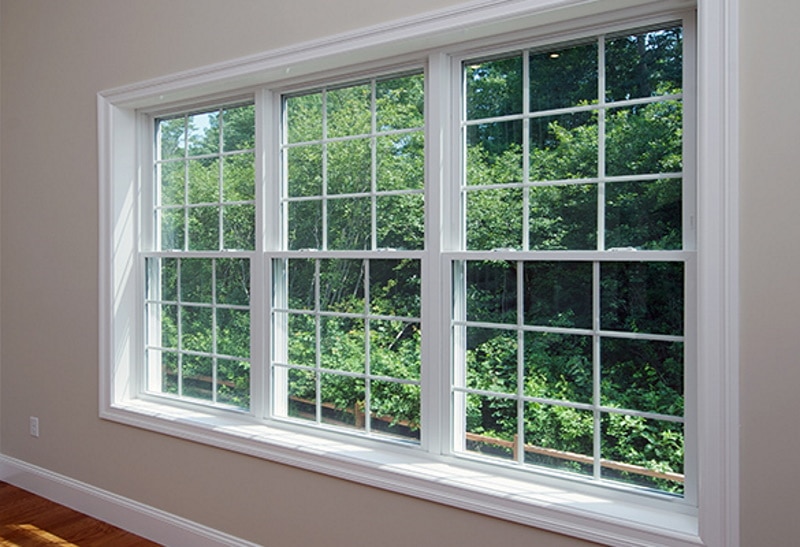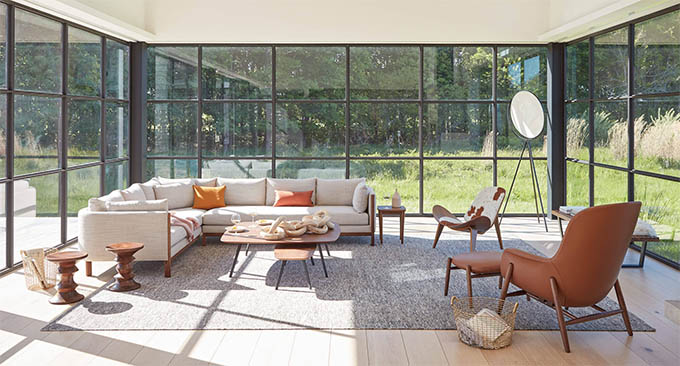Full Frame vs. Insert Window Replacement: What are the Differences?
-
Ingrid Yeh
- Last updated:

Windows play an integral role in both the appearance and function of a home. There are a lot of factors to consider when replacing a window(s) in your home—more than just which one looks the best. While it may seem like a daunting undertaking with an overwhelming number of options to choose from, installing new windows is almost always a worthwhile upgrade and investment for your home, provided you choose the best option and solution for your situation.
Aside from curb appeal, other important factors to think about include the budget and timeframe you’re working with, as well as which replacement method will maintain the architectural integrity of your home while also optimizing the energy efficiency of its window openings. Time, price, functionality, and visibility of your new windows are all helpful things to factor into your decision making when choosing the best new windows for your home.
Unless you’ve replaced a window before or have home construction knowledge, you may not know the available options you have to choose from. Every scenario has its own specific requirements and best solution for it—most of which can be narrowed down to two options: a full-frame window replacement or an insert window replacement.
What’s the best window option for your home?
Full-frame windows and insert windows each have their advantages and setbacks. Being informed about both options and which situation they each fit best with will help you decide which one is most suitable for your home.
This article will provide a simplified and straightforward comparison of all the pros and cons of both full-frame and insert window replacements, as well as the ins and outs of how they each work and which situation they each fit best with. After all, a quality installation of a new window is just as important as which product you choose, if not more.
It’s easy to be intimidated or overwhelmed when considering different options for a big purchase like new windows. Having this info handy will help you feel more confident in whichever option you decide to go with. Read on to learn which window replacement is best for you.

Full-Frame Window Replacement Overview
Simply put, a full-frame window replacement is when the existing window is completely removed down to the studs and a new window is then installed into the opening in its place. This means removing every element of the window—including both its interior and exterior trim, mainframe, and siding if applicable—all the way down to the studs of the wall.
Just as it sounds, a full-frame window replacement is a rather comprehensive replacement method. It looks similar to new home construction, as it involves fully removing and replacing the entire window unit and exposing a rough opening in the wall of framing studs. As such, it is no small feat and generally costs more than insert window replacements, but naturally this method comes with a few advantages as well.
When are Full-Frame Replacement Windows Your Best Option?
A full-frame replacement window is ideal when you’re looking to change the size, shape, and style of your windows, as well as the overall look and feel of your home. What’s more, unless you’re intentionally choosing a new window style with less glass area, a full-frame window replacement also ensures you don’t lose any glass surface of your window as is usually the case with an insert window replacement. This method is also ideal for existing windows made of vinyl, aluminum, or fiberglass.
Because a full-frame window replacement requires stripping everything—framing, trim, and sashes—down to the wall studs, this option is also best for when there is any signs of rotting or deterioration along the window frame, casing, trim, or any part of the exterior wood components. The full removal of the original window allows the professional installer to really get in there to remove any existing rot as well as inspect the rough opening for any signs of water damage to prevent it from spreading.
Choosing this option also makes way for increased energy efficiency for your home as a result of the perfect sash-to-frame fit. With this method, you can also opt to add insulation around the perimeter of the window’s opening if deemed necessary. As each window is built as a single unit, doing so adds an additional air-water barrier to minimize air leakage, which is purposely designed to provide excellent energy savings.
What’s more, if you happen to opt for a full-frame replacement with a cladded wood window, the window’s exterior also become essentially maintenance-free upon replacement—saving you a lot of stress and money in the long run.

Disadvantages of Full-Frame Window Replacements
On the flip side, full-frame window replacements do come at a cost (literally) and have their share of disadvantages. As they are such big projects that require fully removing and replacing the original window, the process of removal and installation is generally more extensive as well as more expensive.
With a full-frame window replacement, you’re replacing more than just the window. Multiple variables are involved and the entire process of removing the old window and installing the new window is more complex, which naturally takes more time to complete. Compared to an insert window, a full-frame window replacement project is estimated to take two to three times longer to complete from start to finish.
Due to how big of a project a full-frame window replacements are, there is both additional work and materials needed which can drive up the total costs. Although different factors of the particular job ultimately determine the total costs involved, the difference of a full-frame window replacement can run approximately 20%-25% more than the cost of an insert window replacement, which can be anywhere between an additional $500-$600, of which one third of that accounts for the cost of materials.
Of course, choosing the right professionals for the job who are both skilled and knowledgeable about how to best complete your project can also be costly. Important considerations like the best removal and installation for your home’s specific exterior (i.e., stucco, exposed brick, wood paneling, etc.) requires a certain knowledge level and skillset that you surely don’t want to skimp on. As full-frame window replacements involve such a complex process from start to finish, you’re not just paying for the work to be completed but, more importantly, for the quality of a job well done.
Full-Frame Window Replacements: Breakdown of Pros and Cons
- Allows you to change up the size, shape, and overall style of your windows without losing any glass surface
- You can check for any rot present in any part of the window and remove it to prevent it from spreading more
- Professional installers can inspect the window’s rough opening for signs of water damage and correct the issue before installing the new window
- Adding insulation around the perimeter of the window opening is possible if needed
- The new window is installed to be a perfect fit within its frame, reducing air leakage and increasing energy efficiency in your home
- The removal and installation process involved is much more extensive and complex
- The entire replacement process can take two to three times longer than an insert window replacement
- Generally more costly than insert window replacements
Insert Window Replacements Overview

For years, the insert window replacement method has been considered the most practical install method, as well as the most common. It offers a quicker and generally easier solution for replacing a window while causing minimal disturbance to the surrounding area on the house. For instance, homeowners that would like to maintain the beautiful, detailed trim of their house without taking away from its historical look would likely opt for insert windows over a full-frame window replacement.
This method involves installing the new insert windows, sometimes called “pocket windows”, within the existing framework. Assuming the existing frame is still in good condition with the trim and casing intact, only the old sash, covers, and hardware are removed and then replaced. Both the interior and exterior trim remain in place and the new insert window is simply pocketed into the existing opening (hence the nickname).
When are Insert Window Replacements Your Best Option?
The insert window replacement is preferable over the full-frame replacement method in several scenarios. As the much simpler option between the two, there are a number of advantages of going with this replacement method when changing up the windows of your home.
Perhaps the main advantage of insert replacement windows is that it keeps your interior and exterior wall trims intact while preserving the original frame. Especially compared to full-frame window replacement, installing new insert windows is usually a much quicker and easier replacement option that is also generally installer-friendly. Not to mention – it’s a more budget-friendly option that is usually less expensive than a full-frame window replacement.
If you’re not looking to significantly change up the style of your windows, then insert windows are a good choice as the new windows are simply installed into the existing framework of the old windows. If the existing window frame is still level and square, you can easily find insert replacement windows of the same shape, size, and operating style as the original windows with the only trade off being a slightly smaller glass surface.
Also, if there are no signs of rot or deterioration anywhere within the window frame, then there is really no reason to go with a full-on full frame. Without any rot or water damage to remove and repair, you may as well go for the less complicated, less time-consuming, and less expensive method of an insert window replacement.
Although this replacement option is much simpler of a project than full-frame window replacements, you will still want to make sure to hire experienced professionals to properly install your new window units and ensure they fits properly within the existing openings. After all, the better the installation, the better your new windows will perform regarding your home’s energy efficiency.

Disadvantages of Insert Window Replacements
While the method of insert replacement windows is the easier and more practical option for many reasons, it comes with its disadvantages as well.
For one, insert windows are only a viable option depending on the condition and material of the existing window frame. The practicality of this method is limited in that only works if the original window’s framework is wooden, unlike a full-frame window replacement which can be applied to aluminum, fiberglass, vinyl, and other window frame materials. As such, insert windows are typically replaced with either solid wood or cladded wood windows.
Keeping the existing wood casings in place when installing insert windows is only a temporary fix that will just need to be replaced again eventually. The size of the window’s overall glass surface is also sacrificed as your new window unit will be smaller than the original in order for the installation to work. So, if preserving the glass surface area of your window is important to you, you may need to reconsider if an insert window replacement is the best option for you.

Insert Windows Replacements: Breakdown of Pros and Cons
- A good option for homeowners with smaller projects and tighter budgets
- Typically less expensive than full-frame replacement windows
- Installation is much less complicated, which makes for a quicker and easier project turn-around time
- Offers a quick solution for a window replacement without disturbing the surrounding trim and area of the home
- You can maintain the existing framework and both the exterior and interior trim of the original window
- Only works for existing frames that are wooden and in good condition
- The overall glass surface of the new window is reduced and will be smaller than the original window
- By leaving the existing wood casings, they will need to be replaced again eventually
Conclusion
Installing new windows is almost always a worthwhile investment that can really give your home a fresh, new, bright-eyed look. While it may seem like a big undertaking with an overwhelming amount of options to choose from and factors to consider, we hope this article helps to simplify the decision making process for you. Whether going with a full-frame window replacement or opting for insert replacement windows, we trust that you’ll make the best possible informed decision for you and your home.
Featured Image Credit: Harvey Windows.com
Contents

